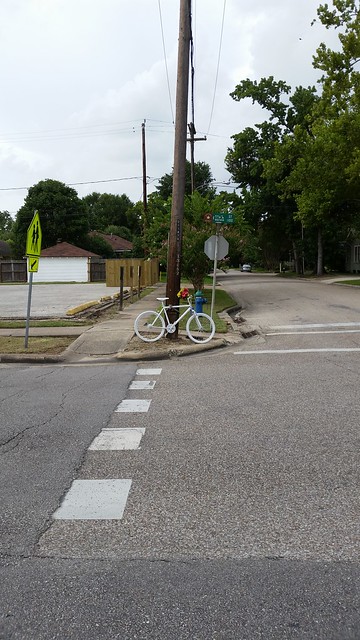It’s been two years since bicyclist Chelsea Norman was killed by drunk hit-and-run driver Margaret Mayer. The city has taken numerous steps to help make the streets safer for bicyclists. How are we doing on that?
“I personally don’t feel that the streets are any safer,” said Hector Garcia, who helps organize cycling events around Houston.
Up-to-date, verifiable counts for cyclist fatalities can be tough to obtain, but online databases and Houston Chronicle archives show that nine bicyclists were killed this year through Nov. 29 in the Houston area, excluding crashes in rural areas of counties adjacent to Harris County. That compares to 14 in 2014.
Even with the likely decline, however, cyclists say more must be done to reduce accident rates, especially inside Houston’s city limits.
[…]
Outreach to local politicians, meanwhile, has increased since Norman’s death, said Michael Payne, executive director of BikeHouston. To some extent, the advocacy group’s growth can be traced to the attention Norman’s death and others received in 2013.
“Cities and conditions change when people get involved,” Payne said. “Cycling, civil rights, you pick the issue. Houston has the cyclists. For too long we were a highly-fragmented group. United, we are getting recognition and a seat at the table.”
The city, with some prodding by Payne and others, is developing a bike master plan. That in itself is progress, Payne said.
“The city must set goals on how it wants to evolves and come up with a plan to get there,” he said.
Change will be gradual. Bike lanes and other features would commonly be added as streets are repaired or redesigned, meaning it could be years before new infrastructure is in place. Designs for improvements to Alabama and T. C. Jester incorporate bike amenities.
Payne says progress since Norman’s death has been limited.
“While not strictly a failure, I would have liked to have seen the city council and the mayor take a more aggressive stand on issues like distracted driving, speeding and DUI,” Payne said.
Recall that Mayer and Norman’s collision had fatal consequences, based on the investigation and trial, because Mayer had been drinking, not because Norman was on a bike.
“These are behaviors which are killing very large numbers of Houstonians, mainly people in cars, and we know that we can make improvements here with a bit of courage,” Payne said.
That’s something that I think tends to get overlooked in the often-polarizing discussion about bike safety in Houston: A lot of the things we could do to make the roads safer for pedestrians and bicyclists would also make them safer for cars and their occupants. That’s largely because the vast, overwhelming majority of accidents are caused by drivers. As this recent NHTSA press release notes, “NHTSA research shows that in an estimated 94 percent of crashes, the critical cause is a human factor. In contrast, vehicle-related factors are the critical reason in about 2 percent of crashes.” (See this Reuters story and this Ars Technica story, which is where I found that NHTSA link, for more on that.) Anything we can do to reduce the likelihood of drivers doing the sorts of things they do that lead to accidents makes us all safer. That includes things like Complete Streets, texting while driving bans, continued education and outreach about drunk driving, actually enforcing existing ordinances like the Safe Passing law, and more. We all know you can’t fix stupid, but you can mitigate against it.

